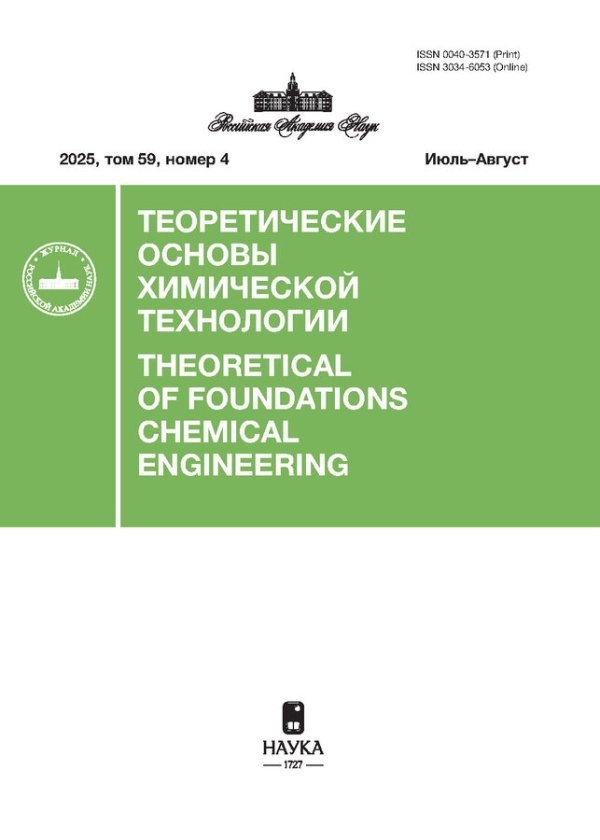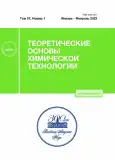Theoretical Substantiation of the Mechanism of Ultrasonic Dehydration of Materials Without a Phase Transition of Liquid Into Vapor
- Authors: Khmelev V.N.1, Shalunov A.V.1, Golyx R.N.1, Terentiev S.A.1, Nesterov V.A.1
-
Affiliations:
- Biysk Technological Institute, FSBEI HE I.I. Polzunov Altai State Technical University
- Issue: Vol 57, No 1 (2023)
- Pages: 60-70
- Section: Articles
- Published: 01.01.2023
- URL: https://journals.rcsi.science/0040-3571/article/view/138400
- DOI: https://doi.org/10.31857/S0040357123010062
- EDN: https://elibrary.ru/CBIACY
- ID: 138400
Cite item
Full Text
Abstract
The article theoretically substantiates the ability of ultrasonic vibrations to dehydrate capillary-porous materials due to the dispersion of moisture from the capillaries and pores of the material under the action of shock waves formed by cavitation bubbles. A phenomenological model is presented based on the analysis of the slow growth of a distorted cylindrical cavitation bubble, taking into account the influence of the cylindrical capillary walls limiting its oscillations. The optimal range (150–170 dB) of ultrasonic pressure levels is revealed, at which the mechanism of cavitation moisture dispersion is realized. It is established that the optimal conditions for the action of ultrasonic vibrations on a dried material are realized when the dimensions or thicknesses of the layer of the dried material correspond to the length of ultrasonic vibrations in air.
About the authors
V. N. Khmelev
Biysk Technological Institute, FSBEI HE I.I. Polzunov Altai State Technical University
Email: grn@bti.secna.ru
Biysk, Russia
A. V. Shalunov
Biysk Technological Institute, FSBEI HE I.I. Polzunov Altai State Technical University
Email: grn@bti.secna.ru
Biysk, Russia
R. N. Golyx
Biysk Technological Institute, FSBEI HE I.I. Polzunov Altai State Technical University
Email: grn@bti.secna.ru
Biysk, Russia
S. A. Terentiev
Biysk Technological Institute, FSBEI HE I.I. Polzunov Altai State Technical University
Email: grn@bti.secna.ru
Biysk, Russia
V. A. Nesterov
Biysk Technological Institute, FSBEI HE I.I. Polzunov Altai State Technical University
Author for correspondence.
Email: grn@bti.secna.ru
Biysk, Russia
References
- Tsai S.C., Song Y.L., Tsai C.S., Yang C.C., Chiu W.Y., Lin H.M. Ultrasonic spray pyrolysis for nanoparticles synthesis // J. Mater. Sci. 2004. V. 39. P. 3647.
- Boucher R. Drying by airborne ultrasonics // Ultrason. News. 1959. 3. P. 8–9.
- Legay M., Gondrexon N., Person S.L., Bontemps A. Enhancement of Heat Transfer by Ultrasound: Review and Recent Advances // Int. J. Chem. Eng. V. 17. 2011.
- Musielak G., Mierzwa D., Kroehnke J. Food Drying Enhancement by Ultrasound – A Review // Trends Food Sci. Technol. 2016. V. 56. P. 126–141.
- Carcel J.A., Garcıa-Perez J.V., Riera E. et al. Ultrasonically Assisted Drying. In Ultrasound in Food Processing: Recent Advances // Chichester, UK: John Wiley and Sons. 2017. P. 371–391.
- Rodrıguez O., Eim V., Rossello C. et al. Application of Power Ultrasound on the Convective Drying of Fruits and Vegetables: Effects on Quality // J. Sci. Food Agric. 2018. Vol. 98. P. 1660–1673.
- Onwude D.I., Hashim N., Janius R. et al. Non-Thermal Hybrid Drying of Fruits and Vegetables: A Review of Current Technologies // Food Sci. Emerg. Technol. 2017. V. 43. P. 223–238.
- Carcel J.A., Garcıa-Perez J.V., Riera E. et al. Ultrasonically Assisted Drying. In Ultrasound in Food Processing: Recent Advances // Chichester, UK: John Wiley and Sons. 2017. P. 371–391.
- Baslar M., Toker O.S., Karasu S., Tekin Z.H., Biranger Yildirim H. Ultrasonic applications for food dehydration #41 // Handbook of Ultrasonics and Sonochemistry. 2016. P. 1247–1270.
- Szadzinska J., Mierzwa D., Pawłowski A., Musielak G., Pashminehazar R., Kharaghani A. Ultrasound- and microwave-assisted intermittent drying of red beetroot // Drying Technology. 2020. V. 38:1-2. P. 93–107.
- Beck S.M., Sabarez H., Gaukel V., Knoerzer K. Enhancement of convective drying by application of airborne ultrasound – A response surface approach // Ultrason. Sonochem. 2014. V. 21. P. 2144–2150.
- Николюк О.И. Влияние ультразвукового способа сушки на качество макаронных изделий с печенью // Вестник Воронежского государственного университета инженерных технологий. 2016. № 3. С. 189–194.
- Bhangu S., Ashokkumar M. Theory of Sonochemistry // Topics in Current Chemistry. 2016. P. 374.
- Хмелев В.Н., Шалунов А.В., Хмелев С.С., Цыганок С.Н. Ультразвук. Аппараты и технологии: монография. Бийск: Изд-во Алт. гос. техн. ун-та, 2015.
- Розенберг Л.Д. Физика и техника мощного ультразвука. В 3 т. т. 2. Мощные ультразвуковые поля / под ред. Л.Д. Розенберга. М.: Наука, 1968.
- Margulis M.A. Sonochemistry and Cavitation. London: Gordon and Breach Publishers, 1995.
- Красильников В.А., Крылов В.В. Введение в физическую акустику. М.: Наука, 1984.
- Голых Р.Н. Повышение эффективности воздействия ультразвуковыми колебаниями на процессы в системах с жидкой фазой: дис. докт. техн. наук 05.17.08 [Текст] / Голых Роман Николаевич. 2021 [Место защиты: ФГБОУ ВПО “Алтайский государственный технический университет им. И.И. Ползунова”].
Supplementary files















